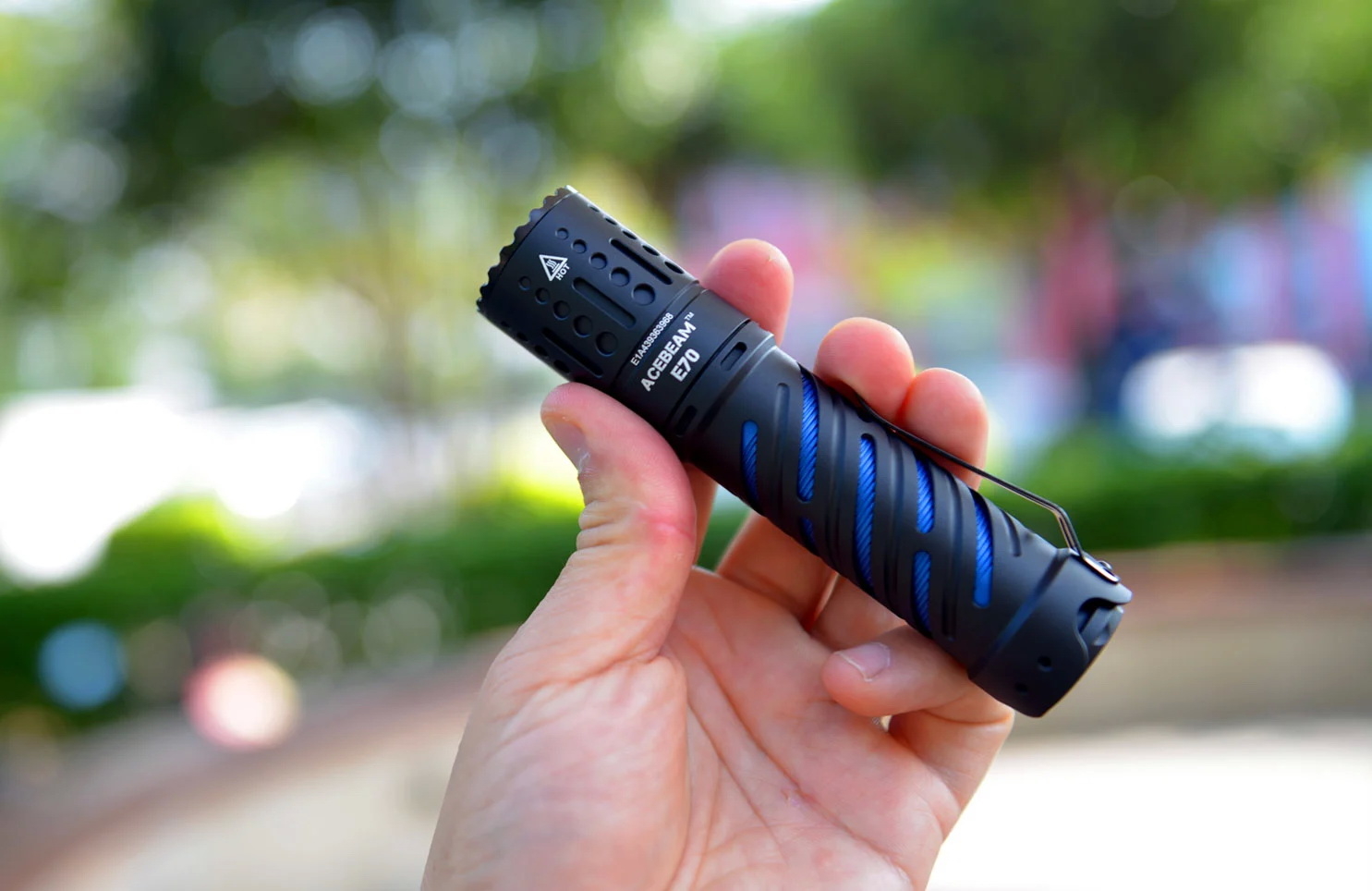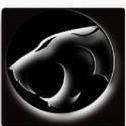Introduction
This review is brought to you by a stroke of good luck. I was looking at the Acebeam E70-AL as the design and specifications had caught my eye, when I stumbled upon a giveaway the company was doing on BLF. Tyche ruled in my favour and upon receiving my prize, I decided that a review was in order.
Acebeam is well known amongst torch enthusiasts as a higher end company and both their products and their price tags reflect that. The Acebeam E70-AL may not be the most value for money option available but the specifications and quality are way beyond what you will find in budget friendly lights.

Are you interested to see what the Acebeam E70-AL has to offer? Let's start at the beginning.
Unboxing
The Acebeam E70-AL comes in a white box with a clear window that allows a view of the light. The box emphasizes the 5 year warranty and the high efficiency, constant current boost circuit, both attesting to the high quality of the Acebeam E70-AL.
The back side of the box does not offer any more information on specifications, but rather the company address, a few QR coded links and the usual certification logos.


The top and bottom have no print, so nothing to show. One of the longer sides lists the possible applications of the light while the other shows if the battery is included, the LED colour temperature and a warning regarding safe usage.
Regarding the LED choice, there is 6500K which is what my prize came with, 5000K and another option not depicted on the box, which has recently been added to the company's website, a 95+ CRI 4500K LED. The 6500K and 5000K are 6V LEDs while the 95+ CRI 4500K is a 12V LED and comes with a different driver.
The output of the 6500K emitter is rated at 4600 Lumen, the 5000K 10% less (according to an company representative) and the 95+ CRI 4500K emitter at 2500 Lumen.


The box features magnetic closure and opens like a book to reveal its contents and a thank you note from the company.


The accessories include a charging cable, 2 spare O-rings, a storage bag and a lanyard not pictured here as it came attached to the light (as seen in the photos above). The leaflets include the manual, a warranty card, safety instructions and a note explaining the battery is in the light and the insulation sheet needs to be removed before use.

I removed the lanyard to better show the light, which features a unique design.
The Acebeam E70-AL is made of aluminium and has flawless machining and anodization. The anodization of the main body is black and there is an inner tube which is anodized blue. The design is very harmonious and pleasing to the eye.
The bezel is crenulated and the head features alternating circular and oblong designs which work well together.
The 8 oblong grooves are meant to house 12x2mm tritium vials according to Acebeam, but are not deep enough to completely cover them, measuring only 1.60mm in depth. As the glass tritium vials are very fragile, protruding equals 100% chance of breaking. There are some hard to obtain 11.5x1.4mm and 10x1.5mm tritium vials that would fit nicely but even if you can find them, the colour choice is quite limited. I would suggest to Acebeam to either make the grooves deeper by 0.5mm or, if not possible, to not advertise them as fit to house 12x2mm tritium vials.
The body of the light features a helix design, with cut outs revealing the blue anodized inner tube and creating a beautiful visual effect. It also features 6 oblong grooves where it connects to the head that are meant to house 6x1.5mm tritium vials and are perfectly sized for it.


The tail part of the tube features tapped holes where the simple and functional clip comes pre-attached. There are 3 sections at the back end of the body. One with the clip installed, one with tapped holes, where the clip could be moved to - no idea why though - and one with bigger holes, where the lanyard came pre-installed.
Removing the lanyard is very easy but re-installing it requires thin tweezers, hence why the company probably opted to ship the light with the lanyard already installed.




In total, the Acebeam E70-AL features an intricate design which looks quite busy but still harmonious and pleasing to the eye. The machining of such a design is not an easy feat, especially with the level of detail and quality we see here.

The business end of the light comes with a protective plastic film, which must be removed before use.
Under the protective film, we can see the shallow orange peel reflector and the Cree XHP70.2 emitter. The combination of such a large LED with the shallow OP reflector guarantee a very floody beam.


The back end of the light is quite simple. It is where the switch for the operation of the light is located. I like the simple, recessed design of the switch which allows the light to tail stand and helps to protect from accidental activation.
The web address of the company is printed in white, which I find unnecessary and deducting from the aesthetics of the light. I do not mind the name of the light and the hot warning symbol printed at the front, but I would also prefer it if the CE and crossed out bin symbols were omitted.


The head and body unscrew to reveal that the battery ships inside the light, with the positive terminal insulated for safety. The threads are square cut, smooth and come nicely greased.


The battery is an Acebeam branded 21700 Li-Ion battery, rated at 5100mAh and it features a USB C port near the positive terminal.


Both battery contacts feature thick, good quality springs. These are probably adequate, but I would have still liked to see double springs or spring bypass wires in such a powerful light, to reduce the resistance even further. This would not have changed the brightness, as the Acebeam E70-AL features a boost driver, but could have helped a little with efficiency and run times.
As mentioned before, there is an inner tube, as the light features an electronic switch at the back and both the negative terminal of the battery and the switch need to be connected to the driver. On the driver end, the silver ring seen on the perimeter contacts the outer tube and connects to the battery negative and the two gold plated contacts near the perimeter connect to the inner tube and transfer the switch presses. The spring in the middle of the driver makes direct contact with the positive terminal of the battery.
Having springs on both ends makes the light resilient to bumps and drops, as the battery is suspended between two springs under pressure and is not likely to momentarily disconnect and turn the light off.

Quality
We have already seen the extraordinary quality the Acebeam E70-AL has, for a production light. Even at close inspection, both the machining and the anodization are perfect.
No edge is sharp, not a single spot less than perfectly anodized. This is indeed a top quality light.


Specifications
The specifications of the Acebeam E70-AL, as mentioned on the company's website, can be seen in the following table:

The Acebeam E70-AL is made of aerospace grade aluminium which has premium type 3 hard anodization. It features the very powerful Cree XHP70.2 LED which allows it to achieve an impressive maximum brightness of 4600 Lumen. The maximum throw distance is 240m, which means that the light is very floody, as expected from the configuration of the LED and the reflector.

The Acebeam E70-AL is quite resilient and sturdy, with an IP68 water proof rating and a 1m impact resistance

User Interface
The user interface of the Acebeam E70-AL is simple and intuitive.
Despite featuring a recessed button, a lock mode and the ability to hard lock the light by unscrewing the head 1/4 of a turn, a double click is required to turn the light on. This prevents accidental activation of unlocked lights and protects even the most careless of users from accidental activations, which would be disastrous with such a powerful light.

The user interface of the Acebeam E70-AL is as follows:
-
From Off
- Double click to turn on (with memory for the 4 main modes), click again to turn off.
- Click and hold from off to turn on at Moonlight mode. Keep holding until if flashes three times to lock the light. Click and hold again to unlock into Moonlight mode.
- Triple click for Strobe. Click to turn off or double click for Turbo.
-
From On
- Click to turn off.
- Hold to cycle through the main modes (Low, Mid1 ,Mid2, High).
- Double click for Turbo. Double click again to return to previous mode.
- Triple click for Strobe. Click to turn off or double click for Turbo. From Turbo, click to return to previous (before Strobe) mode. There is no way to go directly from Strobe to a previous, non Turbo mode.

The rated output and runtimes of all the modes can be seen in the table below.

Beam-shots
The beam pattern of the Acebeam E70-AL is exactly what can be expected from a large emitter combined with a shallow, orange peel reflector. The light is very floody, with a large hot spot and a lot of spill.

I tested the Acebeam E70-AL outside, over a distance of 70m.

The following video shows a comparison of the Acebeam E70-AL with the Emisar D4V2 Ti (with 4 Cree XP-L HI 5000K emitters) and the Fireflies E07 (with 7 Nichia 219b sw45k emitters).
Driver
The driver of the Acebeam E70-AL is a digitally regulated, constant current boost driver, which should be able to maintain constant brightness regardless of the battery voltage and also features smart temperature control, reverse polarity protection and low voltage protection. Very refreshing to see such a high quality driver.
There is no PWM in any of the modes.


Tint and Size Comparison
The tint of the Acebeam E70-AL is cool white at 6500K (5000K and 4500K with high CRI options are also available) and it is definitely above BBL and distinctly green. This is by no means a pleasing tint nor is the light high CRI. The intend was to maximize output and efficiency.
In the comparison photo below, you can see the Acebeam E70-AL in the middle, compared to the more neutral tint of the Emisar D4V2 Ti (with Cree XP-L HI 5000K emitters) on the left and the much rosier tint of the Fireflies E07 (with Nichia 219b sw45k emitters) on the right.

The above photo also offers a size comparison between the lights. The Acebeam E70-AL is not a light that can be easily carried in your trousers pocket, but it fits fine in a winter jacket or a backpack.
Battery and Charging
The battery included with the Acebeam E70-AL is a 21700, rated at 5100mAh and features onboard USB C charging.


The specifications of the Acebeam IMR21700NP-510A with Built-in USB C Port, as shown on the company's website, are listed in the following table:

I measured the capacity of the battery at exactly 4716mAh which is rather low. The battery's internal resistance was measured at 26mΩ. The light has Low Voltage Protection and turns off when the battery voltage drops to 2.7V.
Charging the Acebeam IMR21700NP-510A with Built-in USB C Port is very easy. Just connect the provided cable or any other USB C cable to the charging port and its other end to a charger. Both USB A to USB C and USB C to USB C cables can be used as well as any charger, including the ones that support PD. This is very convenient as you can charge the Acebeam IMR21700NP-510A with Built-in USB C Port with any USB C cable and charger you have at hand. The LED on the battery lights up red to indicate that it is charging and turns green when the charging is completed, at 4.14V.


The Acebeam IMR21700NP-510A with Built-in USB C Port took 6 hours, 22 minutes and 27 seconds to charge from 2.7V to 4.14V. The maximum current drawn was 0.899A, which is low for a 21700 battery and explains the very long charging time. A charging circuit which can support 2A charging would have been much better.
As the specifications indicate that the standard charging current is 1A, I can't help but wonder if it would be OK to charge the battery at 2A through a charger with large enough cradles to fit a protected button top 21700.

A very nice feature of the Acebeam IMR21700NP-510A with Built-in USB C Port is its ability to function as a power bank. This is facilitated by the USB A port on the included charging cable, but a USB C to USB C cable can also be used, even for devices that do not support power delivery.
When the Acebeam IMR21700NP-510A with Built-in USB C Port is functioning as a power bank, its indicative LED turns blue.


There is no information available regarding the current the battery can provide through its USB C port so I had to investigate. Anything above 2.7A and the circuit would immediately reset. I gradually reduced the current until I found it to be initially stable at 2A, which is a good output. Unfortunately, this only worked with a fully charged battery and after 40 minutes of drawing 2A, the circuit started resetting. At the end of the test, and after countless resets, the battery voltage was 3.14V.

I tempered my expectations and tried drawing 1A from the battery and this seems to be the maximum supported current for the power bank function, as the battery was able to maintain it with stability for 3 hours, before the circuit reset a few times and then turned off. I would have much preferred it if it had turned off without the resets, as I am not sure if they could damage any sensitive equipment being charged. The battery voltage at the end of the test was 2.99V.

The Acebeam IMR21700NP-510A with Built-in USB C Port is a battery packed with nice features such as onboard USB C charging and power bank functionality, along with a large 5100mAh capacity. Nevertheless, the actual capacity of 4715mAh and the slow charging speed leave something to be desired, especially considering the $23.90 price tag.
EDC Bulb
Along with the light and battery, my giveaway prize included a nice little accessory which adds a lot of value to the Acebeam IMR21700NP-510A with Built-in USB C Port. It is the Acebeam EDC Bulb.

The Acebeam EDC Bulb attaches to the top of the Acebeam IMR21700NP-510A with Built-in USB C Port and connects to the battery's USB C port to draw power.
The installation and operation are explained in the animation below.

The specifications of the Acebeam EDC Bulb as found on the company's website, are in the following table:

This tiny plastic attachment adds a lot of functionality to the Acebeam E70-AL and is a must buy, especially since it normally costs only $3.99 and is currently on offer for a mere $0.10. Unfortunately, it is also out of stock.
The modes that the Acebeam EDC Bulb supports, along with their respective run times, are listed in the table below:

The Acebeam EDC Bulb is so simple and at the same time so useful and nicely implemented! It really adds value to the Acebeam IMR21700NP-510A with Built-in USB C Port.


Current Draw
The Acebeam E70-AL has a low parasitic drain that is below the ability of the clamp meter to measure. The Moonlight mode only draws 20mA. The Low, Mid1, Mid2 and High modes need 83mA, 216mA, 748mA and 1.961A respectively and Turbo required 10.40A.


These values are rather low for the Lumen output and attest to the efficiency of the driver and emitter combination.
Output & Runtimes
The Acebeam E70-AL with the 6500K emitter is rated at maximum of 4600 Lumen and 240m of throw.
I do not own a multi thousand dollar worth integrating sphere, just a logging Lumen meter and a home made integrating tube. The array is calibrated with 3 separate, professionally measured lights and gives me consistent results, but there is definitely room for error and deviations are to be expected.
According to my measurements, the maximum output (at turn on) was 4494 Lumen, which is short of the advertised 4600 but still very close to the specs and definitely within the error margin of my equipment. ANSI output (at 30 seconds) was 3805 Lumen and the rapid output decline continued down to 1210 Lumen at 57 seconds. It then stayed stable at a very impressive for the size of the light 1218 Lumen for a further 1 hour and 54 minutes! After that, it stayed for 5 minutes at 153 Lumen and finally dropped to 53 lumen for a further 53 minutes, before it turned off.
The temperature regulation was very good and the body of the light was within the ability of a person to hold with bare hands. The test was done indoors, without any cooling or ventilation, so the results will be even better outside.

The following graph shows the first 10 minutes of the Full Runtime Graph in greater detail.

The stability and efficiency of the Acebeam E70-AL are truly impressive and make for a very usable and reliable light. In contrast to the unregulated drivers used in more budget oriented lights, the driver of the Acebeam E70-AL features a constant current output, providing a stable and constant light output and long run times.
Turbo output is short, as dictated by thermal regulation and the laws of physics, but it is there for the short bursts that it may be needed for. High output is incredibly steady and lasted for an impressive 1 hour and 55minutes, after the turbo activation, which is 10 minutes more than what the specifications say.
According to the specifications, the maximum throw of the Acebeam E70-AL is 240m and the maximum intensity 14400cd. I measured 210m and 11005.28cd.
I charged the battery of the Acebeam E70-AL with an external charger to 4.20V, to see if I can squeeze any more performance out of the light but the gain was minimal, increasing the maximum output from 4494 Lumen to 4561 Lumen, the maximum throw from 210m to 214m and the maximum intensity from 11005.28cd to 11437.92cd. Therefore, I think that the company's decision to terminate the charging at 4.14V and thus increase the longevity of the battery is correct.
Conclusion
The Acebeam E70-AL is a light that emphasizes quality.
The machining is intricate with no imperfections or sharp edges. The type 3 hard anodization is uniform and without flaws. The driver is fully regulated and provides constant current output without any PWM on any of the modes, while being very efficient. The Cree XHP70.2 emitter contributes to the high output and efficiency of the light.
The User Interface is simple and functional and extra care has been taken to prevent accidental activations.
The size is normal for a 21700 light and not too easy to fit into trousers pockets, although not impossible. I would prefer to carry the Acebeam E70-AL in my backpack or in the pocket of a winter jacket.
The optional Acebeam IMR21700NP-510A with Built-in USB C Port battery features USB C onboard charging and Power Bank functionality while the Acebeam EDC Bulb optional accessory adds a lot of usability and value.

The Acebeam E70-AL can be purchased directly from the company's website and the cost at the moment this review is written is $94.80, including the battery and shipping, worldwide. The light without the battery costs $74.90, but keep in mind that only button top protected 21700 batteries that can provide at least 10.40A of current will work.
Let's list the Pros and Cons of the Acebeam E70-AL:

Pros
+ Digitally regulated constant current boost driver which provides stable output and high efficiency with no PWM.
+ High Turbo output for the size of the light.
+ Long runtimes.
+ Impeccable and intricate machining.
+ Perfect type 3 hard anodization.
+ Aerospace grade Aluminium Alloy construction.
+ USB type C charging integrated in the battery.
+ Low Voltage Protection.
+ Quality springs on both sides of the battery.
+ Smart ITS Temperature Control.
+ Simple and intuitive UI.
+ 6 slots for 6x1.5mm tritium vials.
+ IP68.
+ The battery provides Power Bank functionality.
+ The Acebeam EDC Bulb optional accessory is very useful.

Cons
- The 8 slots on the head meant to house 12x2mm tritium vials are only 1.60mm deep and cannot protect the fragile glass vials so are not fit for purpose.
- The battery is expensive.
- The battery takes a long time to charge.
- Actual battery capacity is 4716mAh instead of 5100mAh.
- A holster should be included.
Thanks to Acebeam for doing the giveaway and Tyche for providing the light for review

Polymeros Achaniotis 24/08/2021
-
 9
9









Recommended Comments
There are no comments to display.
Create an account or sign in to comment
You need to be a member in order to leave a comment
Create an account
Sign up for a new account in our community. It's easy!
Register a new accountSign in
Already have an account? Sign in here.
Sign In Now